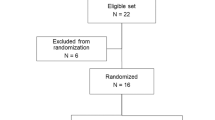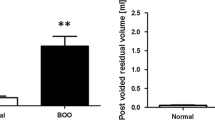Abstract
Introduction and hypothesis
Anticholinergics are used to treat overactive bladder. Anticholinergic agents such as propiverine hydrochloride reportedly increase plasma catecholamine levels in rats. It is also known that active urethral closure mechanisms prevents stress urinary incontinence (SUI), which is enhanced by central and peripheral noradrenergic system activation. Therefore, we examined the influence of propiverine hydrochloride on urethral anti-incontinence function in rats.
Methods
Adult female rats were divided into propiverine and vehicle-treated groups. The propiverine group was given propiverine orally once a day for 2 weeks, after which urethral function and plasma concentrations of catecholamine (dopamine, norepinephrine, epinephrine) were tested.
Results
Urethral baseline pressure measured by a microtransducer-tipped urethral catheter and leak-point pressure during passive intravesical pressure elevation were significantly increased in the propiverine group compared with the vehicle group. Plasma norepinephrine and epinephrine levels in the propiverine group were also significantly increased.
Conclusions
Propiverine treatment that increases plasma catecholamine levels could contribute to improvement of SUI conditions by increasing urethral resistance.



Similar content being viewed by others
Abbreviations
- SUI:
-
Stress urinary incontinence
- A-URS:
-
Amplitude of urethral responses during sneezing
- UBP:
-
Urethral baseline pressure
- LPP:
-
Leak-point pressure
- MUI:
-
Mixed urinary incontinence
References
Khullar V, Chapple C, Gabriel Z, Dooley JA (2006) The effects of antimuscarinics on health-related quality of life in overactive bladder: a systematic review and meta-analysis. Urology 68:38–48
Nishijima S, Sugaya K, Kadekawa K, Naka H, Miyazato M (2009) Comparison of the effect of anti-muscarinic agents on bladder activity, urinary ATP level, and autonomic nervous system in rats. Biomed Res 30:107–112
Nishijima S, Sugaya K, Kadekawa K, Ashitomi K, Yamamoto H (2011) Efficacy of propiverine, an anticholinergic agent, in young and old rats. Life Sci 89:456–459
Kamo I, Torimoto K, Chancellor MB, de Groat WC, Yoshimura N (2003) Urethral closure mechanisms under sneeze-induced stress condition in rats: a new animal model for evaluation of stress urinary incontinence. Am J Physiol Regul Integr Comp Physiol 285:R356–R365
Kamo I, Cannon TW, Conway DA et al (2004) The role of bladder-to-urethral reflexes in urinary continence mechanisms in rats. Am J Physiol Renal Physiol 287:F434–F441
Kaiho Y, Kamo I, Chancellor MB, Arai Y, de Groat WC, Yoshimura N (2007) Role of noradrenergic pathways in sneeze-induced urethral continence reflex in rats. Am J Physiol Renal Physiol 292:F639–F646
Miyazato M, Kaiho Y, Kamo I et al (2008) Effect of duloxetine, a norepinephrine and serotonin reuptake inhibitor, on sneeze-induced urethral continence reflex in rats. Am J Physiol Renal Physiol 295:F264–F271
Lee JY, Cannon TW, Pruchnic R, Fraser MO, Huard J, Chancellor MB (2003) The effects of periurethral muscle-derived stem cell injection on leak point pressure in a rat model of stress urinary incontinence. Int Urogynecol J Pelvic Floor Dysfunct 14:31–37
de Groat WC, Fraser MO, Yoshiyama M et al (2001) Neural control of the urethra. Scand J Urol Nephrol Suppl 207:35–43
Kadekawa K, Nishijima S, Ashitomi K et al (2012) Excitatory effect of propiverine hydrochloride on urethral activity in rats. Int J Urol 19:575–582
Steers WD (2002) Overactive bladder (OAB): what we thought we knew. Eur Urol Suppl 1:3–10
Andersson KE, Appell R, Cardozo L et al (2005) Pharmacological treatment of urinary incontinence. In: Andersson KE, Khoury S, Wein A (eds) Incontinence: 3rd International Consultation on Incontinence. Plymbridge Distributors, Plymouth, p 819
Madersbacher H, Murtz G (2001) Efficacy, tolerability and safety profile of propiverine in the treatment of the overactive bladder (non-neurogenic and neurogenic). World J Urol 19:324–335
Kreder KJ Jr, Brubaker L, Mainprize T (2003) Tolterodine is equally effective in patients with mixed incontinence and those with urge incontinence alone. BJU Int 92:418–421
Dorschner W, Stolzenburg JU, Griebenow R et al (2000) Efficacy and cardiac safety of propiverine in elderly patients—a double-blind, placebo-controlled clinical study. Eur Urol 37:702–708
Dorschner W, Stolzenburg JU, Griebenow R et al (2003) The elderly patient with urge incontinence or urge-stress incontinence—efficacy and cardiac safety of propiverine. Aktuelle Urol 34:102–108
Conflicts of interest
M Nanri and M Kiniwa are both employees of TAIHO Phamaceutical Co.
Author information
Authors and Affiliations
Corresponding author
Rights and permissions
About this article
Cite this article
Kitta, T., Tyagi, V., Nanri, M. et al. Effects of propiverine hydrochloride, an anticholinergic agent, on urethral continence mechanisms and plasma catecholamine concentration in rats. Int Urogynecol J 24, 683–688 (2013). https://doi.org/10.1007/s00192-012-1924-7
Received:
Accepted:
Published:
Issue Date:
DOI: https://doi.org/10.1007/s00192-012-1924-7




